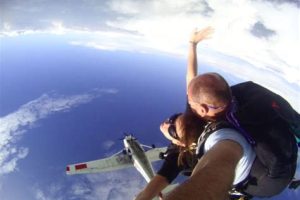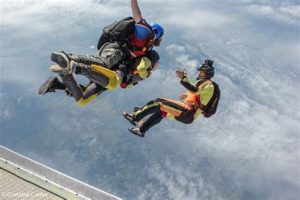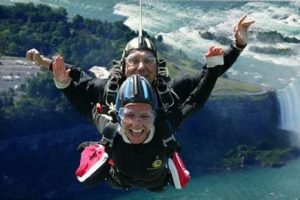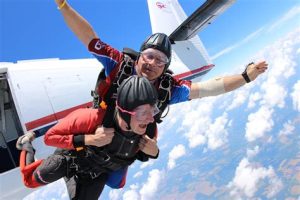Table of Contents
Skydiving Landing Tandem offers the exhilarating experience of jumping out of a plane and landing safely with an experienced instructor. Enjoy breathtaking views and an adrenaline rush as you freefall before gliding through the air and touching down gently. Book your tandem skydiving adventure today!
Are you ready for the thrill of a lifetime? Look no further than Skydiving Landing Tandem, where adventure awaits! Whether you’re an adrenaline junkie seeking an exhilarating experience or simply looking to conquer your fears, our tandem skydiving packages are sure to leave you breathless. Strap yourself in tight as we guide you through an unforgettable journey from the skies to the ground below. But before you take that leap, let us walk you through the instructions, ensuring a safe and enjoyable ride. So, grab your courage and get ready to soar with us!
Introduction
Welcome to the thrilling world of skydiving! If you’ve decided to embark on a tandem skydiving adventure, you’re in for an unforgettable experience. In this article, we will guide you through the process of landing during a tandem skydive, ensuring a safe and enjoyable descent. So, let’s dive right into it!
Preparation for Landing
Before you even board the aircraft for your tandem skydive, your instructor will provide you with detailed instructions on how to prepare for landing. They will explain the proper body position, which is crucial for a safe and smooth landing. It’s important to pay close attention and ask any questions you may have to ensure clarity.
Understanding the Canopy
The parachute, also known as the canopy, plays a vital role in your descent. It slows down your speed and allows for a controlled landing. During the briefing, your instructor will explain the different parts of the canopy and how it operates. Understanding its mechanics will help you feel more confident during the landing.
Body Position
As you approach the landing area, your instructor will guide you on assuming the correct body position. The ideal posture involves bending your knees slightly, maintaining a slight arch in your back, and keeping your feet and legs raised. This position ensures a smooth touchdown and minimizes the risk of injury.
Assessing the Landing Area
As you descend, it’s crucial to have an awareness of your surroundings and the landing area. Your instructor will point out any potential obstacles or hazards that you need to avoid. Keeping an eye on the designated landing zone will help you adjust your body position accordingly and prepare for a precise touchdown.
Communication with your Instructor
Throughout the entire landing process, constant communication with your instructor is essential. They will provide guidance and instructions via hand signals or a radio if equipped. It’s important to stay attentive and respond accordingly, ensuring a synchronized landing with your instructor.
Preparing for Impact
As you near the ground, your instructor will prepare you for the impact by advising you to lift your legs for a flare. This action slows down your descent and allows for a gentle touchdown. Listen carefully to your instructor’s cues and be ready to execute the flare at the appropriate moment.
Touchdown and Rolling
Once your feet make contact with the ground, it’s time to roll forward. Your instructor will guide you through this process, ensuring you maintain stability and prevent any tripping or stumbling. By rolling smoothly, you’ll safely come to a stop and celebrate your successful tandem skydive!
Post-Landing Safety Briefing
After your landing, your instructor will provide a post-flight briefing. They will discuss the highlights of your skydive, address any concerns you may have, and provide instructions for removing the equipment correctly. Following these instructions is crucial to maintain safety protocols and ensure the gear is properly handled.
Reflecting on your Skydiving Experience
Now that you’ve completed your tandem skydive and safely landed, take a moment to savor the exhilarating experience. Reflect on the rush of adrenaline, the breathtaking views, and the accomplishment of conquering new heights. Skydiving is an incredible adventure that leaves lasting memories and often inspires future jumps!
Conclusion
Skydiving landing during a tandem jump requires careful preparation, clear communication with your instructor, and following proper techniques. By paying attention to instructions, assuming the correct body position, and executing the necessary maneuvers, you can enjoy a safe and thrilling descent. Embrace the excitement, enjoy the adrenaline rush, and cherish the memories you create during this extraordinary adventure!
Introduction
Welcome to the ultimate adventure of skydiving with a tandem landing! This manual will guide you through the essential instructions and safety procedures to ensure a memorable and safe skydiving experience.
Please read this instruction manual carefully to understand the instructions and follow all safety guidelines for a successful tandem landing.
We have designed this manual to provide you with step-by-step instructions for the landing phase of your skydiving experience. Let’s get started!
Equipment Requirements
Before commencing your tandem landing, ensure that you are equipped with the necessary skydiving gear. This includes a tandem parachute system, a helmet, and a jumpsuit.
Double-check that all equipment is in good condition, properly fitted, and securely fastened.
If you have any doubts regarding the equipment, seek assistance from a certified skydiving professional before proceeding.
Pre-Landing Safety Instructions
As you descend, the instructor will guide you through a pre-landing briefing. Pay close attention and follow their instructions carefully.
Maintain a stable body position, keeping your legs lifted and slightly bent to absorb the impact during landing.
Keep your eyes on the horizon to help maintain balance and reduce dizziness during the descent.
Landing Approach
Once nearing the landing spot, your instructor will initiate the landing sequence. Follow their directions promptly and without hesitation.
Keep your body in an upright position, with your knees slightly bent and feet together.
Maintain a firm grip on the harness handle provided by your instructor while keeping your hands clear of any lines or toggles.
Touchdown
As you touch down, your instructor will initiate a slide to bring you to a gradual stop. Keep your feet up and avoid dragging them on the ground.
Continue to maintain a stable body position while the parachute slows down and the instructor steers you safely to a complete stop.
After landing, listen to your instructor for post-landing instructions, and remember to enjoy the adrenaline rush!
Emergency Procedures
In the event of an emergency during the landing phase, remain calm and follow your instructor’s directions.
Your instructor will have the knowledge and experience to handle emergency situations swiftly and effectively.
It is crucial to trust your instructor’s expertise and stay focused on their instructions to ensure your safety.
Safety Tips
Always adhere to the safety guidelines provided by your instructor and the skydiving facility.
Avoid consuming alcohol or drugs before your skydiving session, as it impairs judgment and reaction time.
If you have any medical conditions that may affect your ability to skydive safely, consult with medical professionals and inform your instructor beforehand.
Enjoyment and Memories
Remember that skydiving is an exhilarating experience, so relax and enjoy the incredible scenery during your descent.
Capture the moment! Many skydiving facilities offer photography or videography services to document your tandem landing. Check with your instructor for availability.
Cherish the memories of this unique adventure and feel free to share your experience with others to inspire them to take up the thrilling challenge of skydiving!
When it comes to skydiving, the landing is just as important as the exhilarating freefall experience. To ensure a safe and smooth landing for tandem skydivers, proper use of instructions, voice, and tone becomes crucial. Here is a point of view on how these elements should be utilized:
Tone:
1. Clear and concise: The tone used in skydiving landing tandem instructions should be straightforward and easy to understand. Complex or ambiguous language can lead to confusion and potential accidents.
2. Calm and reassuring: Skydiving can be an intimidating experience for first-timers, so the tone should be calming and reassuring. Using a friendly and supportive tone can help alleviate any anxiety the tandem skydivers may have.
3. Professional yet friendly: It’s important to strike a balance between professionalism and friendliness. The tone should convey expertise and competence while still being approachable and welcoming to create a positive experience for the tandem skydivers.
Voice:
1. Authoritative: The voice used in skydiving landing tandem instructions should carry authority to ensure that the directions are followed diligently. This helps establish credibility and trust in the instructions provided.
2. Encouraging: The voice should encourage tandem skydivers throughout the landing process. Positive reinforcement and motivation can help boost their confidence and make the experience more enjoyable.
3. Informative: The voice should provide clear and accurate information regarding the landing procedure. Tandem skydivers need to be well-informed about what to expect and how to execute the landing safely.
Instructions:
1. Step-by-step guidance: The instructions should be organized in a sequential manner, providing tandem skydivers with a clear step-by-step guide to follow during the landing process. This ensures that nothing is missed or overlooked.
2. Visual aids: Incorporating visual aids, such as diagrams or illustrations, can enhance the effectiveness of the instructions. Visual cues help tandem skydivers better understand and visualize the landing techniques.
3. Safety emphasis: The instructions should prioritize safety above all else. Clear explanations of potential risks and how to mitigate them should be included. Reinforcing safety measures throughout the instructions helps instill confidence in the tandem skydivers.
Overall, the use of clear instructions, an appropriate tone, and a confident voice are essential for tandem skydiving landing instructions. By following these guidelines, tandem skydivers can have a safe and enjoyable landing experience, making their skydiving adventure truly memorable.
Thank you for taking the time to visit our blog and learn more about the exhilarating experience of Skydiving Landing Tandem. We hope that this article has provided you with valuable insights and information about this thrilling adventure. Now, before you take the leap from the plane, let’s go over some important instructions to ensure your safety and enjoyment during the tandem skydive.
First and foremost, it is essential to listen carefully to your instructor during the pre-jump briefing. They will guide you through the entire process, from boarding the plane to landing safely on the ground. Pay close attention to their instructions regarding body position, hand signals, and landing techniques. These instructions are designed to keep you safe and help you make the most of your skydiving experience.
Once you are in the air, remember to relax and enjoy the breathtaking views around you. Take in the feeling of freedom as you soar through the sky. Trust your instructor and the equipment that has been thoroughly checked and maintained for your safety. Remember to maintain the correct body position, as instructed, to ensure a stable and controlled descent.
As you approach the landing area, your instructor will guide you on how to extend your legs and prepare for touchdown. Keep your eyes on the horizon and maintain a slightly bent-knee position to absorb the impact. Remember to stay relaxed and let your instructor handle the landing. They have years of experience and will ensure a smooth and safe landing for both of you.
In conclusion, tandem skydiving is an incredible adventure that allows you to experience the thrill of freefall while having the support and guidance of a highly trained instructor. By following their instructions and maintaining the correct body position, you can ensure a safe and enjoyable skydiving experience. So, get ready to embark on this unforgettable journey and create memories that will last a lifetime. Blue skies and safe landings!
.
People Also Ask about Skydiving Landing Tandem:
-
What is tandem skydiving?
Tandem skydiving is a type of skydiving where you are harnessed to an experienced instructor who guides the entire jump. It is the most popular way for beginners to experience the thrill of skydiving.
-
How safe is tandem skydiving?
Tandem skydiving is generally considered safe when conducted by certified instructors and at reputable skydiving centers. The equipment used is regularly inspected, and instructors undergo extensive training to ensure safety. However, like any adventure sport, there are inherent risks involved.
-
What should I wear for a tandem skydive?
You should wear comfortable clothing suitable for the weather on the day of your jump. Avoid loose items like scarves or hats that could become entangled during the jump. Closed-toe shoes are also recommended to protect your feet during landing.
-
How long does a tandem skydive last?
The duration of a tandem skydive depends on various factors such as weather conditions and the altitude from which you jump. On average, the freefall portion lasts around 60 seconds, followed by a parachute ride lasting 5-7 minutes.
-
Is there an age or weight limit for tandem skydiving?
Age and weight restrictions can vary between skydiving centers. Generally, participants must be at least 18 years old and weigh below a certain limit to ensure the safety of both the participant and instructor. It’s best to check with the specific skydiving center for their requirements.
-
What happens if the parachute doesn’t open during a tandem skydive?
In the rare event that the main parachute fails to open, tandem skydivers have a backup parachute known as the reserve chute. The reserve chute is packed separately and is designed to deploy automatically in case of an emergency. The instructor is trained to handle such situations and will ensure a safe landing.
-
Can I bring my own camera for a tandem skydive?
Most skydiving centers have restrictions on bringing personal cameras for tandem jumps due to safety reasons. The instructor or a professional videographer will typically capture your skydiving experience, and you can purchase the video and photos as a keepsake.
Remember to always follow the instructions and guidelines provided by your instructor during your tandem skydiving experience to make it safe and enjoyable!






